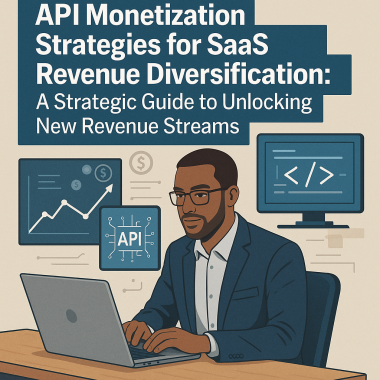The mobile gaming industry is flourishing, with an increasing number of players joining the digital playground. For game publishers, this growth presents a golden opportunity to monetize their offerings effectively. However, the key to successful monetization lies in understanding player behaviors and market trends. In this article, we delve into the best practices for monetization in mobile games, drawing on recent market research. This report was produced by Unity.
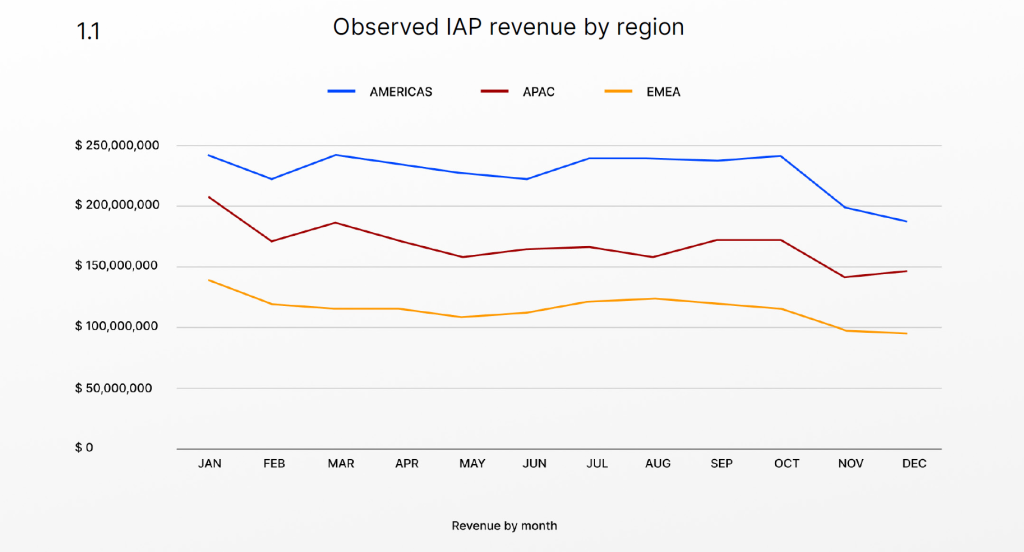
Understanding In-App Purchase (IAP) Dynamics
The Dominance of Currencies, Sales Events, and Bundles
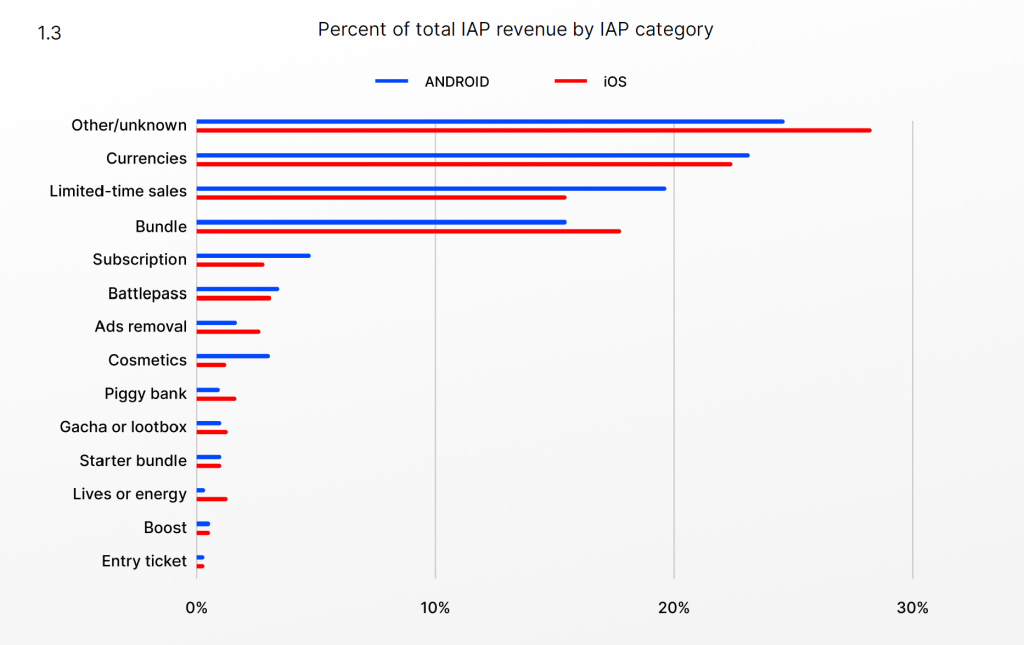
Recent studies reveal that a significant portion of IAP revenue (56% for iOS and 58% for Android) comes from currencies, limited sales events, and bundles. This highlights the importance of incorporating these elements into your IAP strategy. By offering a mix of currencies and time-bound sales events, you can create a sense of urgency and exclusivity, encouraging players to make purchases.
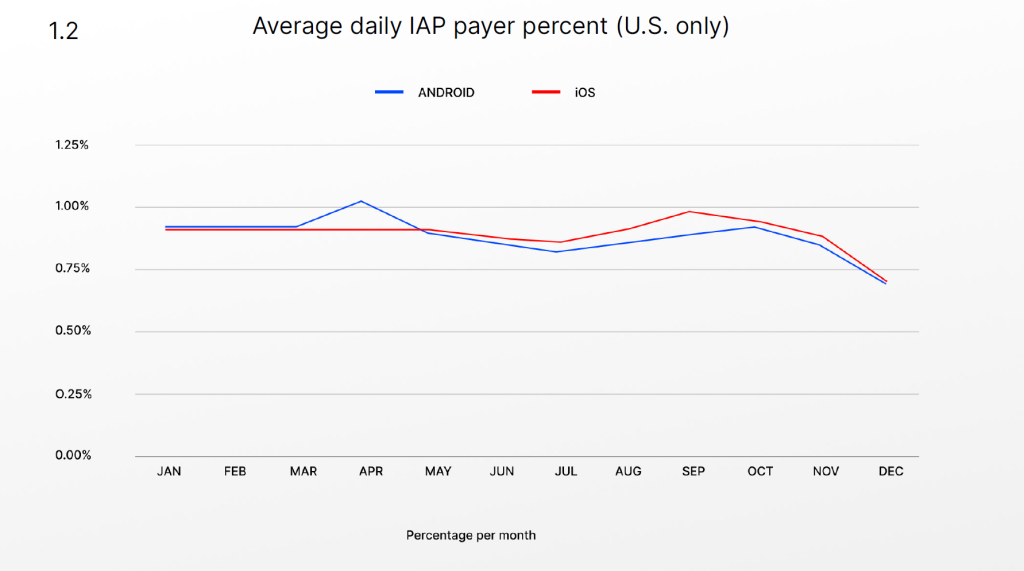
Pricing Strategy: The Sweet Spot
When it comes to pricing, there’s a sweet spot: $1.01–$5.00 USD. This range is particularly effective in converting first-time buyers. Pricing popular items like beginner packs within this range can lead to higher conversion rates, catering to players who are hesitant to make large investments.
The Two-Week Window of Opportunity
An interesting finding is that 77% of players who have ever made an IAP did so within their first two weeks of gameplay. This indicates a critical window for publishers to focus their monetization efforts. Tailoring your IAP offerings during this period, with an emphasis on currencies, limited-time sales, and ad removal, can significantly increase the likelihood of conversion.
Genre-Specific Strategies
Different game genres respond differently to various IAP items. While currencies lead in IAP category revenue (22% for iOS and 23% for Android), limited-time sales and bundles are also significant contributors. It’s crucial to analyze and understand your players’ preferences and purchasing behaviors to tailor your offerings accordingly.
First IAP Conversion: A Gateway to Long-Term Engagement
The first IAP conversion plays a vital role in establishing purchase stickiness. Offering a variety of items, such as currencies, limited-time sales, and ad removal options, can be highly effective in driving first-time conversions. Subscriptions and bundles, being longer-term purchases, should also be part of your strategy.
- Currencies as a Starter Offer: Currencies, being the most straightforward type of IAP, show impressive conversion rates (18% on iOS and 17% on Android). These are typically easy for players to understand and use within the game, making them an ideal entry point for first-time buyers. Offering starter currency packs at an attractive price can nudge players to make their first purchase.
- Limited-Time Sales to Create Urgency: Limited-time sales have proven effective (17% on iOS, 16% on Android) in encouraging first-time purchases. These sales create a sense of urgency and exclusivity, motivating players to seize the opportunity before it disappears. Highlighting these offers prominently within the game can lead to a surge in first-time buyer conversions.
- Ad Removal for Enhanced Experience: For many players, the option to remove ads (converting at 11% on iOS and 7% on Android) is a compelling reason to make their first purchase. This not only enhances their gaming experience but also establishes a value proposition where spending money directly correlates with an improved gameplay environment.
- Bundles and Subscriptions for Long-Term Engagement: Bundles and subscriptions are powerful tools for first-time conversions. Bundles, offering a collection of items at a discounted price, provide tangible value. Subscriptions, on the other hand, create a longer-term relationship with the player, offering ongoing benefits or content. Both strategies can be effective in converting players who are looking for more than a one-off purchase.

Timing and Player Segmentation
Timing is a critical factor in monetization. With 77% of IAP conversions happening within the first two weeks, publishers should focus on targeting new players during this period. After 21 days, it’s generally safe to introduce non-user-initiated ads like interstitials, as most conversions have already occurred. Early implementation of rewarded ads (around day 14) can enhance user experience without risking cannibalization of IAP revenue.
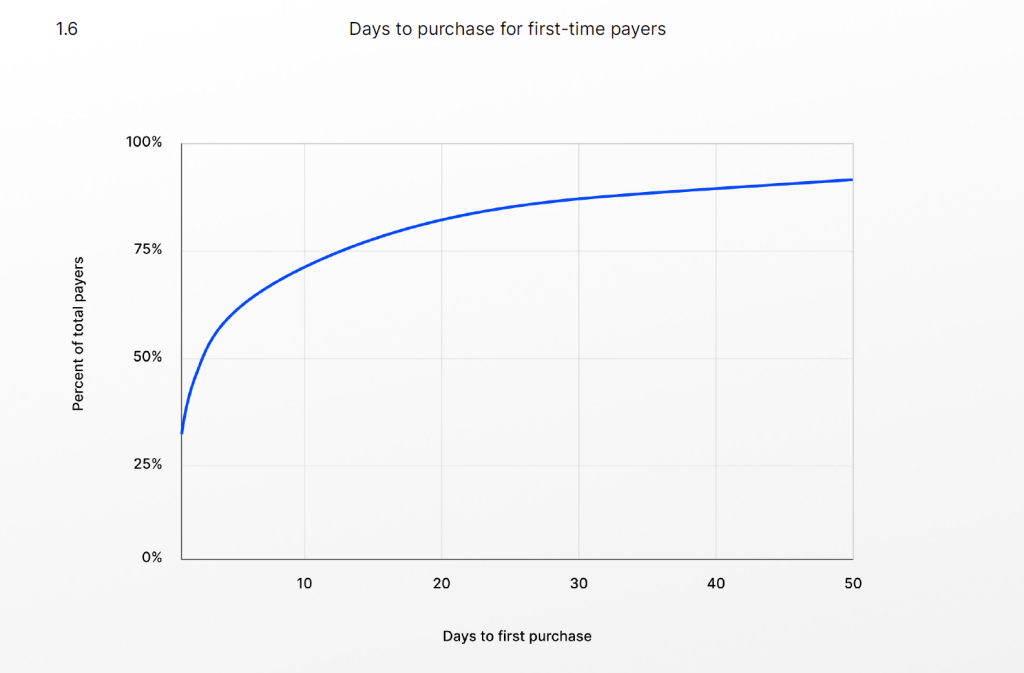
Key Factors to Drive Conversion Effectiveness
- Visibility of Offers: Ensure that your IAP offers are prominently displayed and easy to access. Players should never have to search for ways to spend money.
- Price Point Strategy: The pricing of IAPs should be strategic, considering both the perceived value of the items and the willingness of your target audience to spend. As mentioned earlier, the $1.01–$5.00 range is often effective for first-time purchases.
- Enhancing Player Experience: Any IAP should add value to the player’s experience, whether it’s through advancing faster, unlocking exclusive content, or enhancing gameplay. The perceived value can significantly influence a player’s decision to purchase.
- Progression Boosts: Items that help players progress faster or more efficiently in the game can be particularly appealing. This is especially true for players who are time-constrained or who wish to catch up with more advanced players.
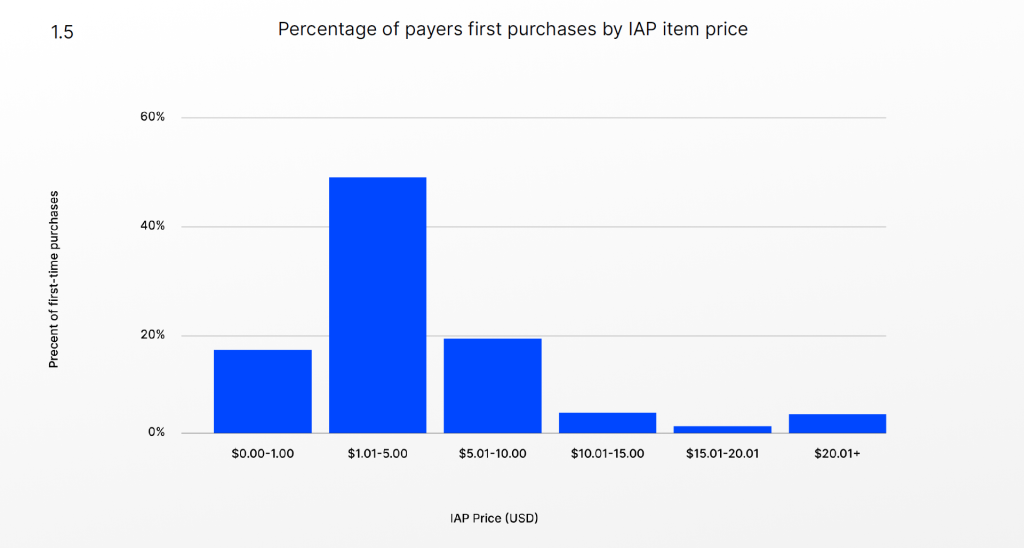
The Appeal of IAA for Non-Paying Players
IAA offers a unique proposition for players who are reluctant to spend money. It provides a pathway for them to progress in the game without financial investment. This approach not only enhances player satisfaction but also exposes them to premium features, potentially paving the way for future conversions to paid services.
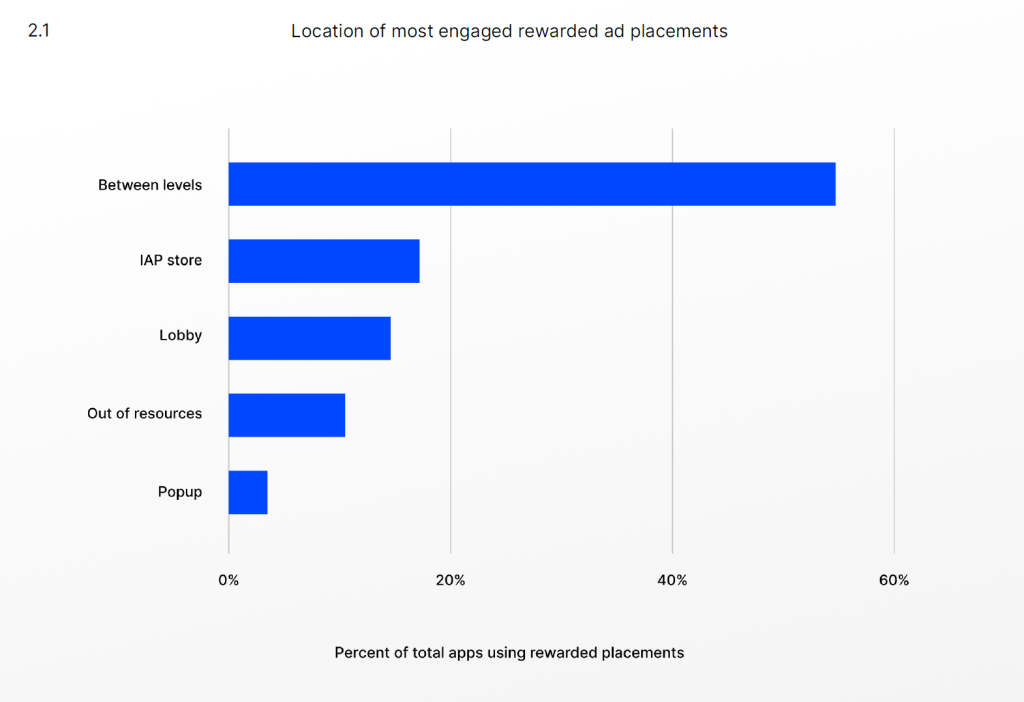
Rewarded Ads: A Win-Win for Players and Developers
Rewarded ads, particularly those placed between game levels, have shown high engagement rates, with a 55% success rate in games. This format benefits players by offering tangible rewards for viewing ads, while developers benefit from increased ad revenue and player retention.
Strategies for Maximizing Engagement with IAA
Placement and Visibility of Ads
To ensure the effectiveness of IAA, it’s crucial to position ads in highly visible areas of the game. This increases the likelihood of engagement and ensures maximum reach among the player base.
High-Visibility Placement Points
- Between Game Levels: Placing ads between levels is a strategy that has proven effective in engaging players. It offers a natural break in gameplay, making it an ideal time for players to view ads.
- In-App Purchase (IAP) Store: Although 18% of games use rewarded video ads in their IAP store, this strategy primarily reaches players already considering purchases. Hence, while this can be a lucrative spot, it may not capture the broader audience.
- Lobby/Pre-Level Placements: Ads placed in the lobby or before a level starts are highly visible and can engage players even if they haven’t completed a single game level. This placement ensures that all players, irrespective of their progress, encounter the ads.
Diversification of Ad Rewards
Diversifying ad rewards is essential to maintain player interest and engagement. The top ad rewards by level of engagement include additional rewards, currencies, and gacha mechanics, accounting for 47% of engagement.
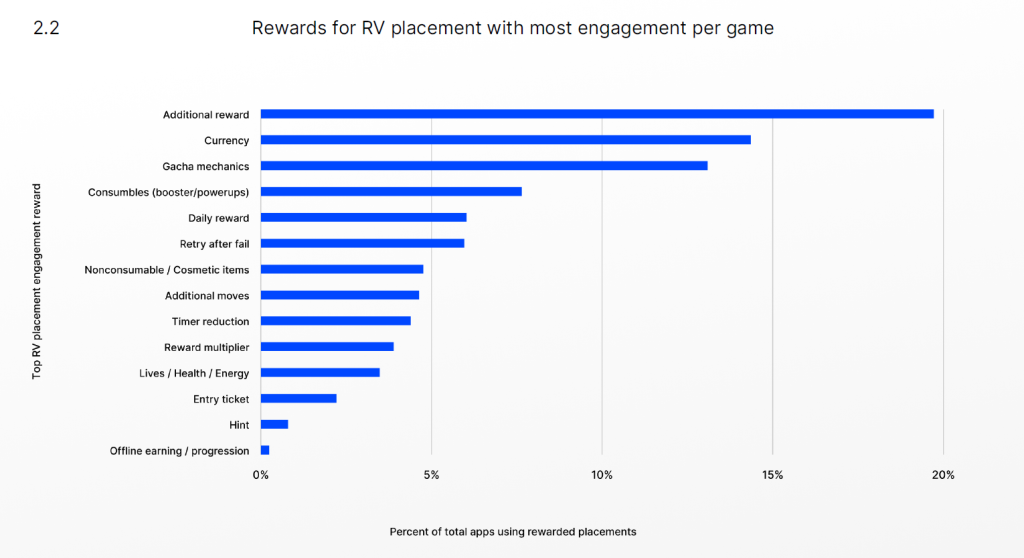
Effective Ad Rewards
- Extra Rewards (20%): Offering additional rewards like extra lives or power-ups can significantly boost player engagement.
- Currency (14%): Providing in-game currency as a reward for watching ads is a compelling incentive for players, helping them progress without spending money.
- Gacha Mechanics (13%): Incorporating gacha elements, where players receive random rewards, adds an element of surprise and excitement, enhancing engagement.
Balancing Monetization with Player Experience
While IAA is a powerful tool for monetization, it’s crucial to balance ad frequency and placement with the overall player experience. Overloading a game with ads can lead to player churn, whereas strategically placed and well-timed ads can enhance the gaming experience and encourage longer play sessions.
Understanding Player Preferences
Gauging player responses to different ad formats and placements can provide valuable insights. Regularly analyzing player behavior and preferences helps in optimizing ad strategies for better engagement and retention.
Best Practices for Implementing IAA
- User-Centric Ad Experiences: Tailor ad experiences to fit seamlessly into the game’s narrative and flow. Avoid intrusive or irrelevant ads that can disrupt gameplay.
- Rewarded Ad Formats: Focus on rewarded ad formats as they offer a value proposition to the player. Ensure the rewards are desirable and contribute to game progression.
- Testing and Optimization: Continuously test different ad formats, placements, and rewards. Use A/B testing to determine what works best for your specific player base.
- Transparent Communication: Be transparent with your players about the use of ads. Explain how ad engagement supports the game and can enhance their experience.
- Quality and Relevance of Ads: Partner with advertisers whose products or services align with your game’s audience. Relevant ads are more likely to be well-received by players.
Understanding Offerwalls in Mobile Games
Offerwalls function like an in-game marketplace, presenting players with various offers they can complete in exchange for in-game rewards, typically game currency. These tasks can range from reaching a certain level in another game, signing up for a subscription, making a purchase, completing a survey, and more. This model not only offers an alternative revenue stream but also enhances player engagement by providing diverse progression paths.
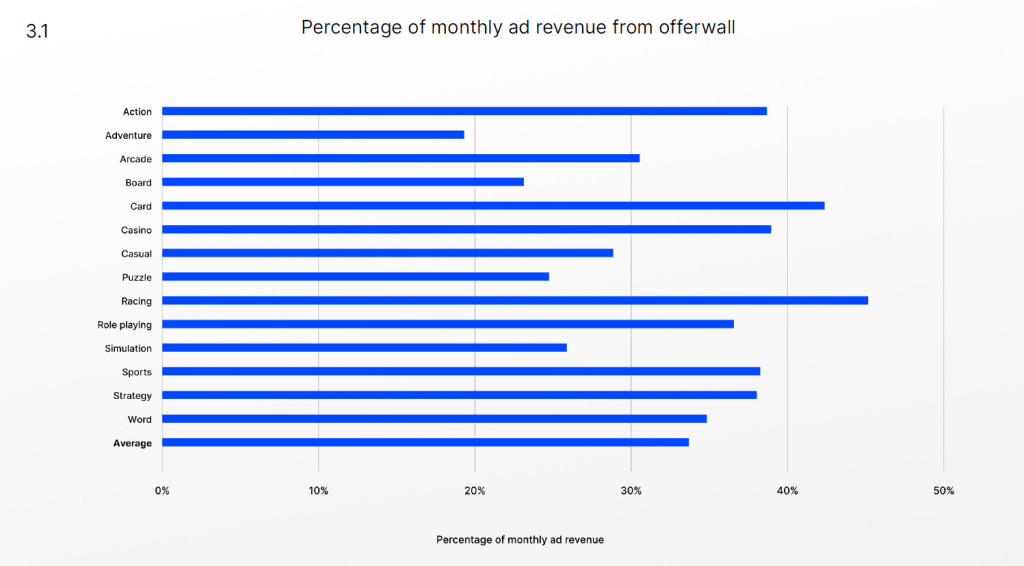
Complementing Core Monetization Strategies
Integrating offerwalls alongside existing monetization strategies like IAP and IAA can significantly enhance revenue diversity. They provide a valuable alternative for players who are reluctant to watch ads or make direct payments for premium content, thereby catering to a broader audience and increasing player satisfaction.
A Substantial Share of Ad Revenue
For games employing offerwalls in conjunction with other monetization methods, offerwalls account for an impressive 33% of total ad revenue. This substantial contribution underscores the effectiveness of offerwalls in diversifying and boosting overall game revenue.
High Payout Potential
Offerwalls can yield high payouts, with some multi-reward offers reaching up to $68 USD per user conversion. This high earning potential makes offerwalls an attractive proposition for game developers seeking to maximize revenue per user.

Enhancing Player Retention
One of the most compelling advantages of offerwalls is their positive impact on player retention. Games implementing offerwalls have reported a Day 90 retention rate of 14% for users who engage with these ads, compared to less than 3% for other players. This increased retention is crucial for long-term game success and player community building.
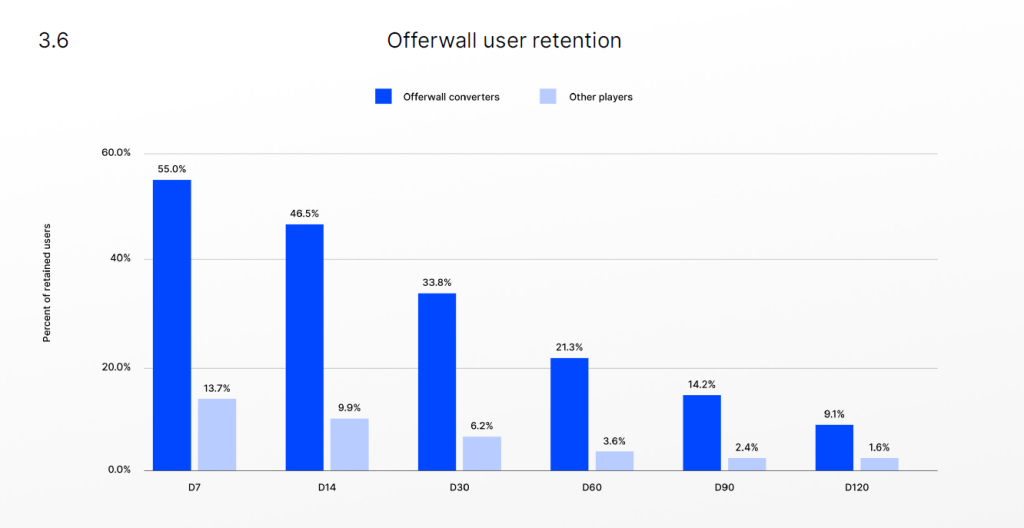
Offerwalls as a Marketplace Within the Game
In challenging economic environments, where resources are limited and meeting revenue targets becomes increasingly difficult, offerwalls offer a viable solution. They provide an additional revenue stream that requires fewer resources to implement and maintain compared to other monetization strategies.
When players successfully fulfill multi-reward tasks, they earn greater amounts of in-game currency, reflecting the increased effort and time investment these tasks demand. Consequently, publishers benefit from higher compensation, with top-performing games witnessing payouts reaching up to $68 for each completed offer, indicative of the higher average revenue per user generated through offerwalls.
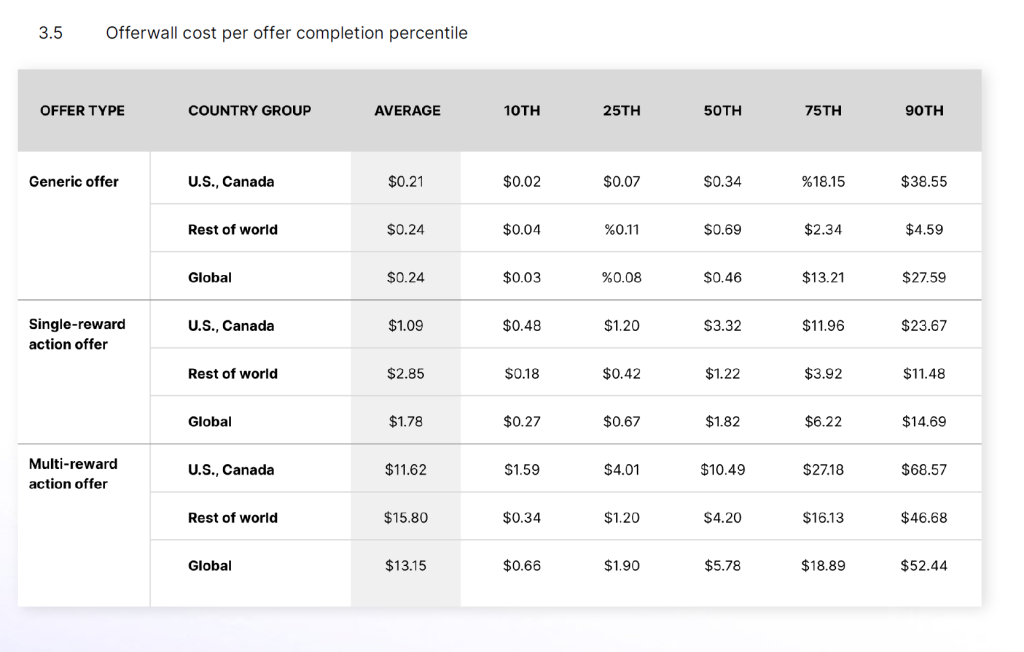
Building Resilient Game Economies
Offerwalls contribute to the resilience of in-game economies by:
- Offering Diverse Player Engagement Options: Catering to players with different engagement levels and preferences.
- Higher Advertiser Payouts: By setting specific engagement targets, advertisers are willing to pay more for high-quality, engaged users.
- Expanding Advertiser Pools: Mobile game studios can attract a wider range of advertisers, including lucrative brands and e-commerce apps targeting gamers.
Balancing Offerwalls with Other Monetization Strategies
Concerns About Cannibalizing IAP
While there’s a concern that offerwalls might cannibalize IAP revenue, this can be mitigated through strategic segmentation tools. By delivering tailored experiences based on player behavior, developers can ensure that offerwalls complement rather than compete with IAP.
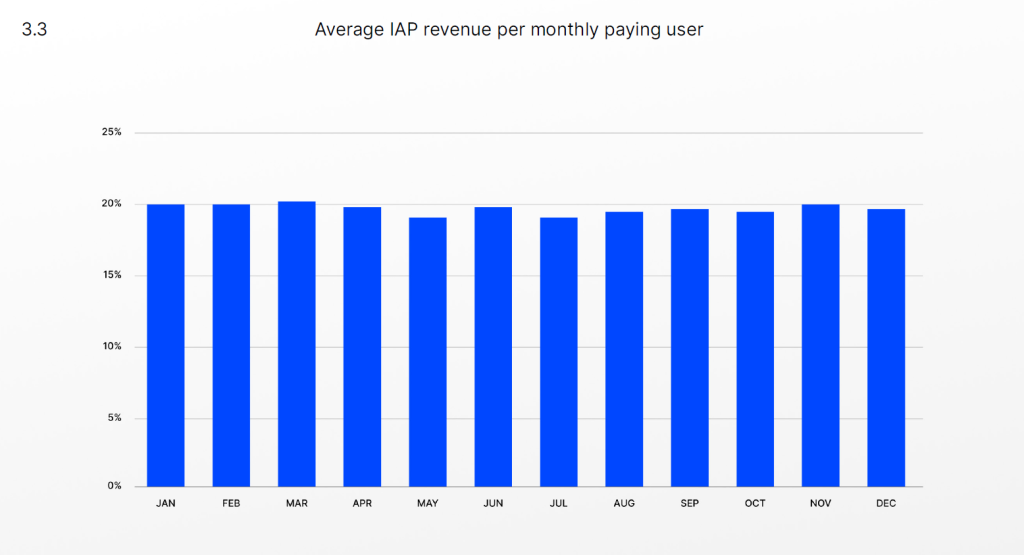
Revenue Analysis
The average monthly revenue per offerwall converter is approximately 25% of the monthly IAP revenue per payer. Given that offerwalls require fewer resources to implement, they represent a valuable addition to the monetization toolkit of many games.
The Power of Hypercasual Environments
Market research shows that 11 out of 15 game genres achieve the best conversion rates (CVR) when advertised within hypercasual games. This finding suggests that advertising in hypercasual environments can be a strategic move for developers seeking higher engagement and conversion, particularly for genres that resonate well with the hypercasual audience.
Genre-Specific Advertising Strategies
One crucial aspect advertisers can control is the choice of genre for placing their ads. The difference in performance metrics from one genre to another can be substantial. For instance, genres like hypercasual can offer significantly better CVR, making them a strategic choice for developers working with limited budgets.
Targeting Specific Markets for Better Engagement
Efficiency in advertising also involves targeting tier-2 countries that show a heightened interest in specific game genres. For example, Japan has emerged as an ideal market for advertising sports games, with a Click-Through Rate (CTR) 13% above the average of all tier-2 countries. Similarly, South Korea shows a 4% higher CTR for trivia and hypercasual games. In contrast, genres like racing or hypercasual underperform in Japan, and action games see a lower-than-average CTR in South Korea.

In the world of mobile gaming, strategic marketing is essential for maximizing returns on investment (ROI), especially when it comes to advertising spend. One key approach lies in targeting specific game genres in tier-2 countries. This focused strategy can significantly enhance the efficiency and effectiveness of marketing efforts, leading to better conversion rates and higher ROI. Let’s delve deeper into the importance of this approach.
Tier-2 countries, often characterized by emerging markets with growing digital infrastructures and increasing smartphone penetration, present unique opportunities for mobile game publishers. These markets are less saturated compared to tier-1 countries (like the US, UK, and Japan) but have a rapidly growing base of mobile users. This makes them ripe for targeted advertising strategies.
Each tier-2 country has its own set of preferences and trends when it comes to mobile gaming genres. For instance, puzzle games might be more popular in one country, while strategy games could have a larger following in another. Understanding these preferences is crucial for creating ads that resonate with the local audience.
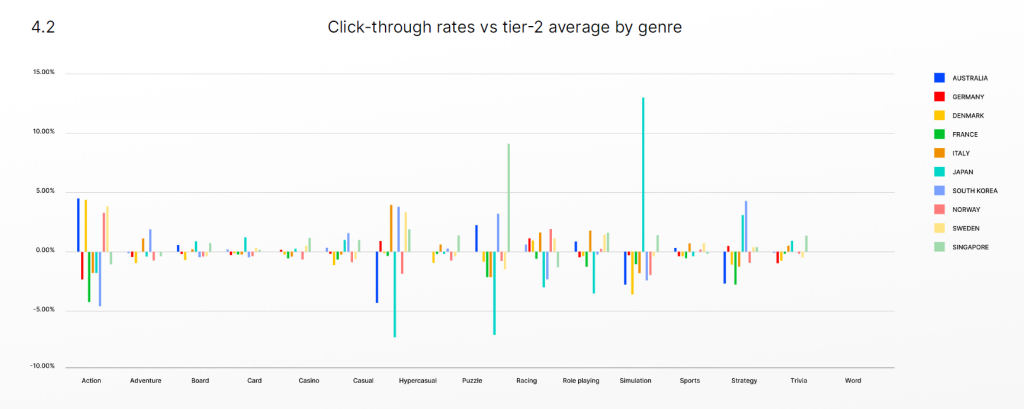
Advantages of Genre-Specific Marketing in Tier-2 Countries
- Increased Engagement and Conversion: Aligning game genres with local preferences can lead to a substantial increase in engagement. For instance, targeting the sports genre in Japan can yield a 13% higher CTR than the average in other tier-2 countries.
- Cost Efficiency: Advertising costs in tier-2 countries are generally lower. This, combined with the targeted approach, can lead to more cost-effective campaigns and a higher ROI. The cost-per-click (CPC) in tier-2 countries can be up to 50-60% lower than in tier-1 countries, offering a significant advantage.
- Reduced Competition: With fewer advertisers vying for attention in tier-2 markets, there’s an opportunity for higher ad visibility and performance. This can result in a lower cost-per-acquisition (CPA) and higher overall campaign effectiveness.
- First-Mover Benefits: Early entry into these markets with genre-specific strategies can establish a strong brand presence. This can lead to long-term benefits, including brand loyalty and organic growth.
- Loyal User Base Development: Effective genre targeting can cultivate a dedicated user base. In markets like Japan, where specific genres resonate more strongly, this can translate into a more engaged and loyal audience.
The Emergence of Custom Store Pages
Custom Store Pages have become a vital tool for developers, allowing the creation of bespoke sales points aligned with specific ad creatives and messages. This approach ensures a consistent user experience, improving the overall performance of campaigns. The advantage of Custom Store Pages lies in their resource efficiency; developers can repurpose existing assets, making it a cost-effective strategy.
Leading the Way with Puzzle, Casino, and Lifestyle Games
Puzzle, casino, and lifestyle games are at the forefront of utilizing Custom Store Pages, comprising 73% of current users. These genres have recognized the potential of Custom Store Pages in crafting targeted, engaging user experiences that resonate with their specific audiences.
Best Practices for Using Custom Store Pages
For iOS, using up to 35 custom pages, and up to 50 for Android, is recommended. This range allows for sufficient testing of variations to determine what resonates best with the target audience.
Custom Store Pages are a vital tool for mobile game publishers, allowing them to create tailored landing pages that align with specific advertising campaigns. These pages can significantly enhance user engagement and conversion rates. Here are ten best practices for building effective Custom Store Pages:
- Consistent Branding: Ensure that your Custom Store Page reflects your game’s branding, including logos, color schemes, and visual themes. Consistency in branding helps in establishing trust and recognition among potential players.
- Targeted Messaging: Tailor the messaging on your Custom Store Page to the specific audience segment you are targeting. Use language and imagery that resonates with that demographic.
- Highlight Unique Features: Emphasize the unique selling points of your game. Whether it’s innovative gameplay, stunning graphics, or a compelling storyline, make sure these features are front and center.
- Use High-Quality Visuals: Invest in high-quality graphics and videos. Visual appeal can significantly impact a user’s first impression and decision to download the game.
- Showcase Reviews and Ratings: Include positive reviews and high ratings on your Custom Store Page. Social proof can be a powerful motivator for new users to try your game.
- Update Content Regularly: Keep your Custom Store Page fresh with regular updates. Feature new events, updates, or seasonal content to maintain user interest.
- Optimize for Search: Use relevant keywords in your page’s text to improve its visibility in store search results. SEO practices are just as important in app stores as they are on the web.
- Clear Call-to-Action: Have a clear and compelling call-to-action (CTA), such as “Download Now” or “Play Today”. Make sure the CTA is prominently placed and easy to find.
- Leverage Analytics: Use analytics tools to track the performance of your Custom Store Page. Analyze metrics like click-through rates and conversion rates to understand what’s working and what’s not.
- A/B Testing: Regularly perform A/B testing with different page layouts, messaging, and visuals. This helps in identifying the most effective elements that drive conversions.
Consistency in Creatives
Maintaining the same creatives across both ads and Custom Store Pages is crucial for creating a seamless user experience. This consistency helps in reinforcing the game’s branding and messaging, leading to better engagement and conversion rates.
Showcasing Game Highlights
Custom Store Pages should feature key aspects of the game, such as events, in-game play, or seasonal content. This approach not only showcases the game’s highlights but also keeps the content fresh and relevant, increasing its appeal to potential players.
Best Practices for Building Custom Store Pages in Mobile Gaming
Custom Store Pages are a vital tool for mobile game publishers, allowing them to create tailored landing pages that align with specific advertising campaigns. These pages can significantly enhance user engagement and conversion rates. Here are ten best practices for building effective Custom Store Pages:
- Consistent Branding: Ensure that your Custom Store Page reflects your game’s branding, including logos, color schemes, and visual themes. Consistency in branding helps in establishing trust and recognition among potential players.
- Targeted Messaging: Tailor the messaging on your Custom Store Page to the specific audience segment you are targeting. Use language and imagery that resonates with that demographic.
- Highlight Unique Features: Emphasize the unique selling points of your game. Whether it’s innovative gameplay, stunning graphics, or a compelling storyline, make sure these features are front and center.
- Use High-Quality Visuals: Invest in high-quality graphics and videos. Visual appeal can significantly impact a user’s first impression and decision to download the game.
- Showcase Reviews and Ratings: Include positive reviews and high ratings on your Custom Store Page. Social proof can be a powerful motivator for new users to try your game.
- Update Content Regularly: Keep your Custom Store Page fresh with regular updates. Feature new events, updates, or seasonal content to maintain user interest.
- Optimize for Search: Use relevant keywords in your page’s text to improve its visibility in store search results. SEO practices are just as important in app stores as they are on the web.
- Clear Call-to-Action: Have a clear and compelling call-to-action (CTA), such as “Download Now” or “Play Today”. Make sure the CTA is prominently placed and easy to find.
- Leverage Analytics: Use analytics tools to track the performance of your Custom Store Page. Analyze metrics like click-through rates and conversion rates to understand what’s working and what’s not.
- A/B Testing: Regularly perform A/B testing with different page layouts, messaging, and visuals. This helps in identifying the most effective elements that drive conversions.
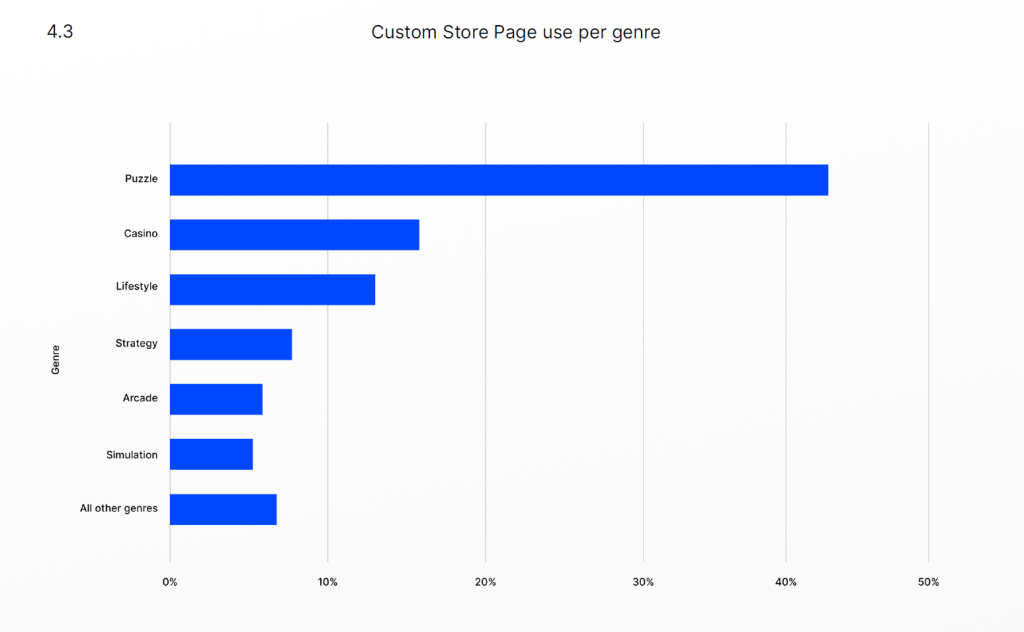
Setting Up Custom Store Pages
To set up Custom Store Pages effectively, mobile publishers should use the tools provided by the platforms where their games are hosted, such as the Apple App Store and Google Play Store. Here’s a guide on how to set them up:
Apple App Store
- Apple’s App Store Connect: Use App Store Connect to create Custom Store Pages for iOS apps. You can create up to 35 custom pages per app.
- Product Page Optimization: Utilize Apple’s Product Page Optimization feature to test different app icons, screenshots, and app previews with a portion of your audience.
Google Play Store
- Google Play Console: For Android apps, use the Google Play Console. You can create up to 50 custom store listings.
- Store Listing Experiments: Use Store Listing Experiments in Google Play Console to A/B test different versions of your app’s store listing with real users.
Cross-Platform Tools
- Third-Party Analytics Tools: Use tools like Sensor Tower, App Annie, or Adjust for deeper insights and analytics on your Custom Store Page’s performance.
- Graphic Design Software: Leverage graphic design software like Adobe Photoshop or Canva to create high-quality visuals for your pages.
- Video Editing Tools: Use video editing tools for creating engaging app previews and trailers. Software like Adobe Premiere Pro or Final Cut Pro can be useful.
By following these best practices and utilizing the right tools, mobile game publishers can effectively create and optimize Custom Store Pages. This not only improves the user experience but also drives higher conversion rates, ultimately contributing to the game’s success in the competitive mobile gaming market.



